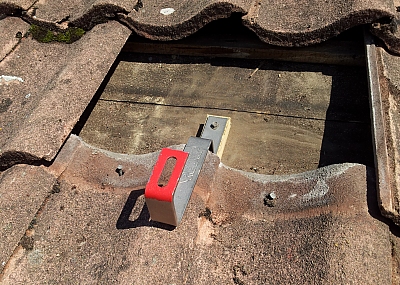With the to-ing and fro-ing from the sellers for wrong parts, it meant that the plan to get the project done this week rather went to pot.
But some progress was made, we got the tower up and started to figure out how to mount the rails.
My friends Peter and James helped massively here, with three brains being better than one and two pairs of hands on the roof being safer than one.
The first problem was that the tiles were arranged so that the vertical wooden rafters were not in line with the troughs in the tile shapes but the peaks (at the edges of the tiles). You can see this in the picture below; the hooks are sitting in the join between tiles.
This meant I needed to make up blocks to raise the hooks. I could have used hooks with lateral adjuster plates or made up wooden blocks between the rafters but this seemed the easiest bodge to do.
Conveniently, I had some treated roof batten wood that was almost exactly the right thickness. It wasn't quite square 25mm, so we could make some blocks with a thicker profile than others (to suit the particular wonkiness of the rafters) and make up the difference with thick galvanised washers as shims.
Of course now the rafter screws that I'd ordered were a bit too short for comfort, so I had to buy longer ones.
There are two pairs of rails for two rows of solar panels... Oh, yeah... The plan? To mount all the 80W panels from the patio and garage roof on two rows; one of 10 panels on top and 8 panels on the bottom. The lower row is fewer because there's a sewer pipe vent poking up though the roof.
I needed two lengths of rail for each row, as the rails are 3.2m long and I have about a 6.0m roof span (allowing some margin around the edge). The lengths are joined together with a U bar insert that bolts them together.
A special T bolt goes into the rail mounting channel and then bolts the rail to the hooks.
A good tip: Don't do this on a really sunny day as you'll burn your hands on the hot concrete tiles :D
 I used 12 hooks on the top row and 10 on the shorter bottom row. In the picture above, you can see I've bolted a sawn-off bit of rail to the top two hooks to use as a make-shift hand rail.
I used 12 hooks on the top row and 10 on the shorter bottom row. In the picture above, you can see I've bolted a sawn-off bit of rail to the top two hooks to use as a make-shift hand rail.Once you get some hooks in the roof and bolt some rail to it, you can move about the roof much more safely, as you have something to stand on other than the tiles, and you can't slip off the roof without the rails stopping your slide.
Helps too to have a tower where the deck is at the exact height of the gutter so that you are effectively stepping on to the roof at "ground" height, rather than clambering up. I now have much less fear of the height. This can be a bad thing though, as fear can keep you alert.
In the sequence below, you can see us moving the tower back and forth and adding the rails from the bottom up, using the first "rung" to make it easy to then add the upper rows.
Finally, the panels just clamp on to the rails using special plate nuts that clip into the rail and can slide along it. Stainless steel hex bolts hold down the panels with end clamps that have to be the same height as the panel frame height. In-between the panels, a U shaped clamp holds adjacent panels to the rails.
You can see these end clamps and inter-panel clamps here:
Note how the clamp on the left is taller than the one on the right because the panels have different frame heights. If I'd been planning ahead, I'd have bought panels with all the same frame height. :D
The inter-panel clamps are universal because they don't actually extend down to the rail. They just grab the panels and then you torque the bolt so that it holds the panel tightly down. Don't go mad with the wrench or else you might crush the panel frame wall and crack the glass!! This is more of a risk on cheap panels that don't have strong frames.
Now, the eagle-eyed among you may have spotted that the two panels in the bottom left are not in line with the rest of the panels in that row. This is an annoying consequence of the old panels on the left having junction boxes that are too big! They stick out below the height of the frame and so when I came to mount them, the junction boxes fouled the rail... GRRRR. There was nothing for it but to mount those two panels lower on the rail, to clear the junction boxes. If I'd checked this before starting, I could have set the rails closer together...
Hiiiigh...Hooooo.... High ho, hi ho, it's off to bodge we go...












